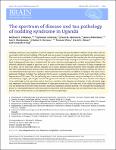The spectrum of disease and tau pathology of nodding syndrome in Uganda
Date
2021Author
Pollanen, Michael S.
Onzivua, Sylvester
McKeever, Paul M.
Robertson, Janice
Mackenzie, Ian R.
Kovacs, Gabor G.
Olwa, Francis
Kitara, David L.
Fong, Amanda
Metadata
Show full item recordAbstract
Nodding syndrome is an enigmatic recurrent epidemic neurologic disease that affects children in East Africa. The illness
begins with vertical nodding of the head and can progress to grand mal seizures and death after several years.
The most recent outbreak of nodding syndrome occurred in northern Uganda. We now describe the clinicopathologic
spectrum of nodding syndrome in northern Uganda. The neuropathologic findings of 16 children or young adults with
fatal nodding syndrome were correlated with the onset, duration and progression of their neurological illness. The
affected individuals ranged in age from 14 to 25 years at the time of death with a duration of illness ranging from
6–15 years. All 16 cases had chronic seizures. In 10 cases, detailed clinical histories were available and showed
that three individuals had a clinical course that was predominantly characterized by epilepsy, whereas the other seven
individuals had progressive cognitive, behavioural and motor decline, in addition to epilepsy. The main neuropathologic
findings included: tau pathology (16/16 cases), cerebellar degeneration (11/16 cases) and white matter
degeneration (7/16 cases). The tau pathology was characterized by filamentous tau-positive deposits in the form of
neurofibrillary tangles, pre-tangles and dot-like grains and threads in the neuropil. All cases showed some degree
of tau pathology in the neocortex and in the locus coeruleus with frequent involvement of the substantia nigra
and tegmental nuclei and lesser involvement of other grey matter sites, but there was a lack of glial tau pathology.
The tau pathology in the neocortex showed a multifocal superficial laminar pattern. We conclude that nodding syndrome
is a clinicopathological entity associated consistently with tau pathology, but our observations did not establish
the cause of the disease, or an explanation for the tau pathology.

